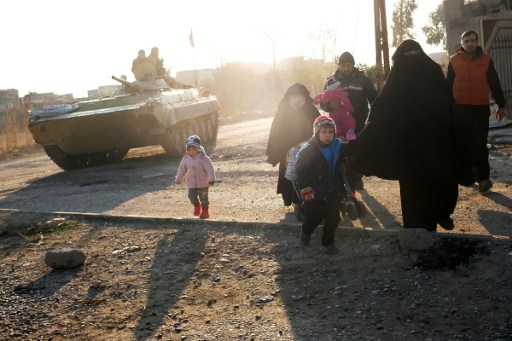Erbil- The declining effectiveness of ISIS attacks against Iraqi forces in eastern Mosul suggests the militants are starting to run out of resources with the campaign in its third month, a U.S. general has said.
Since the U.S.-backed offensive began on Oct. 17, elite troops have retaken a quarter of the city in the biggest ground operation in Iraq since the 2003 U.S.-led invasion that toppled Saddam Hussein.
The second phase of the campaign, launched last week following nearly a month of deadlock, has pushed ISIS out of several more areas in eastern Mosul despite fierce resistance. Iraqi forces have yet to enter the west.
“They’ve got a finite amount of resource that are on the eastern side and the fact that their capability is waning indicates that those resources are starting to dwindle,” U.S. Army Major General Joseph Martin, head of ground forces for the U.S.-led coalition fighting ISIS, told Reuters.
“I see the commanders’ reporting coming in and I see the exquisiteness of their SVBIED (suicide vehicle borne improvised explosive device) system, the sophistication of their SVBIEDs continuing to get lower and lower, the boom of the different IEDs continuing to have a lower yield – all tell me that the enemy’s capacity is diminishing over time. We see that as a positive indicator,” he said in a phone interview from Baghdad.
An arms monitoring group said last month that the militants had been producing weapons on a scale and sophistication that matched national military forces and had standardized production. The technical precision of their work means it could not be described as “improvised” weapons production, it said in a report.
Martin, who took up his post in mid-November, said it was difficult to know how much ordnance ISIS has stockpiled in Mosul.
“They’ve had two years to prepare for this defense and so I don’t know how much stuff they have stored inside mosques, inside of schools, inside of hospitals,” he said.
The coalition shelled a mortar tube on Sunday located between two schools in eastern Mosul, and last week hit a van carrying ISIS militants in a hospital parking lot, possibly incurring civilian casualties.
Martin said the militants were regularly using municipal facilities for military means, including transporting weapons in ambulances.
“As they lose capacity, they never cease to amaze me at the level they will take their despicability. They have done some things during the course of this campaign that I thought, ‘It surely can’t get any worse than that’,” he said.
The coalition has bombed all five bridges connecting east and west Mosul, forcing ISIS to transport casualties across the Tigris River by boat.
Along with Iraq’s air force, the coalition is striking some militant positions in the west but for now, Martin said, “our focus principally is on the east side”.
He said the Mosul campaign was on track, but “in terms of timeline, we’re on Iraqi time. This is going to take some time.”
Iraqi forces made initial quick advances in outlying towns and villages which ISIS had mostly emptied of civilians. But progress slowed as they entered built-up areas of Mosul where they must use caution to avoid civilian casualties.
ISIS has used the terrain to its advantage, concealing car bombs in narrow alleys, posting snipers on tall buildings with civilians on lower floors, and constructing underground tunnels and surface-level passageways between buildings to avoid detection.
Individual fighters have staged attacks in “liberated” areas which Iraqi forces have struggled to clear fully.
Martin compared Mosul to the American city of Philadelphia, with a civilian population of about 1.8 million and almost 3,000 km of roads.
“There’s in excess of 200,000 buildings,” he said. “Let’s say that there’s six rooms in each building … That’s 1.2 million rooms that they’ve got to contend with and make sure that are clear. That’s 1.2 million rooms that they’ve got to discriminate between the enemy and the civilians that live there.”
